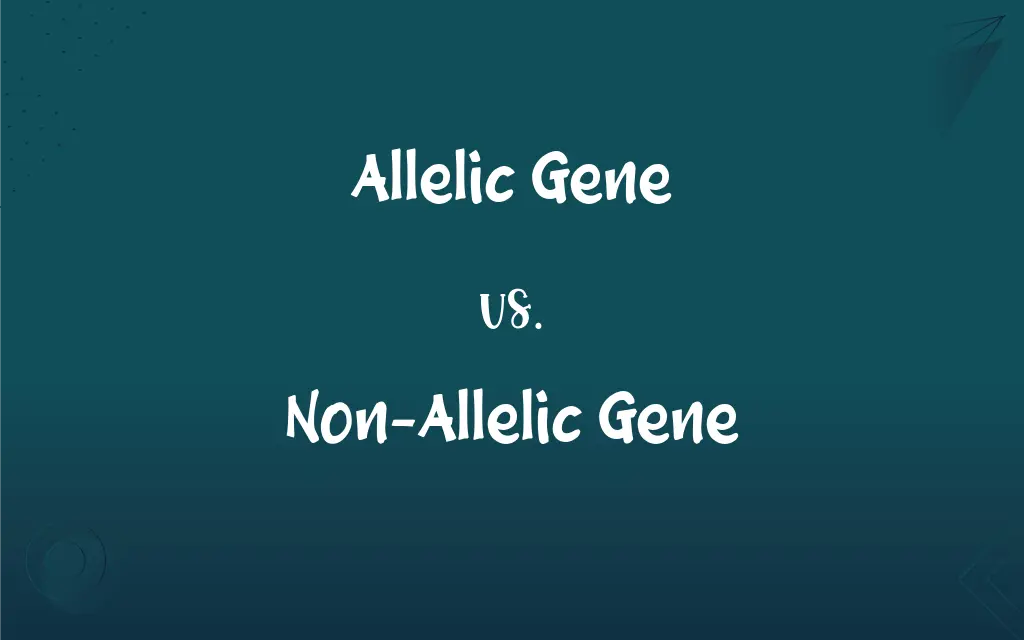Allelic Gene vs. Non-Allelic Gene: What's the Difference?
Edited by Aimie Carlson || By Janet White || Published on March 6, 2024
Allelic genes are different versions of the same gene located at the same position on a chromosome, while non-allelic genes are distinct genes located at different positions on a chromosome.

Key Differences
Allelic genes represent variations of the same genetic sequence, occurring at the same locus on homologous chromosomes. These genes are responsible for the diversity in traits among individuals, as each allele can produce a different outcome in the organism's phenotype. In contrast, non-allelic genes are separate genes located at different loci, possibly even on different chromosomes, and they control different traits or functions within an organism.
When discussing heredity, allelic genes are central to the concept of dominant and recessive traits, as the interaction between alleles (like in Mendelian inheritance) determines the trait that will be expressed. Non-allelic genes, however, may interact in different ways, such as through gene linkage or epistasis, influencing each other's expression indirectly, but they do not follow the same simple dominant-recessive relationship as alleles do.
In genetic disorders, allelic genes can manifest as various forms of a disease depending on which allele is present; for example, different mutations of the same gene can cause varying severities of a condition. On the other hand, non-allelic genes can contribute to multifactorial diseases where multiple distinct genes, each potentially located on different chromosomes, collectively influence the risk and severity of a condition.
Allelic genes undergo recombination during sexual reproduction, leading to new combinations of alleles in offspring and contributing to genetic diversity. Non-allelic genes also undergo recombination, but since they are not alternatives of the same gene, their recombination contributes to genetic diversity in a broader sense, impacting a wider range of traits and functions within the organism.
The study of allelic genes is fundamental in fields like population genetics, where allele frequencies within a population are important indicators of genetic diversity and evolutionary pressures. Non-allelic genes are crucial in the study of complex traits and polygenic inheritance, where the combined effect of multiple genes influences a trait, making the understanding of their interactions and collective impact essential.
ADVERTISEMENT
Comparison Chart
Location
Same locus on homologous chromosomes
Different loci, possibly on different chromosomes
Function
Represent variations of the same gene
Distinct genes controlling different traits or functions
Inheritance Pattern
Follow dominant-recessive relationship
Interaction varies, can involve linkage or epistasis
Role in Disease
Different alleles can cause variations of a disease
Multiple genes collectively influence disease risk
Genetic Diversity
Recombination leads to new allele combinations
Recombination affects a broader range of traits
ADVERTISEMENT
Allelic Gene and Non-Allelic Gene Definitions
Allelic Gene
An allele that dictates a specific trait in an organism.
The allelic gene for flower color resulted in red petals.
Non-Allelic Gene
A distinct gene that is not an alternative version of another.
The non-allelic gene for leaf shape differs from that for leaf color.
Allelic Gene
A version of a gene that has undergone mutation.
The allelic gene mutation caused an unexpected phenotype in the plant.
Non-Allelic Gene
One of multiple genes contributing to a single trait.
The non-allelic gene was part of the group influencing skin pigmentation.
Allelic Gene
An allele that can be either dominant or recessive in genetic expression.
The dominant allelic gene for height overshadowed the recessive allele.
Non-Allelic Gene
A gene occupying its own unique position on a chromosome.
The non-allelic gene for disease resistance resides on chromosome 6.
Allelic Gene
A specific form of a gene at a particular locus on a chromosome.
The allelic gene for eye color determines whether someone has blue or brown eyes.
Non-Allelic Gene
A gene that can suppress or enhance the expression of another gene.
The non-allelic gene interacted epistatically with another, altering the phenotype.
Allelic Gene
A form of a gene carrying specific genetic instructions.
The allelic gene carried the information for the organism's enzyme production.
Non-Allelic Gene
A gene controlling a trait independently of alleles of another gene.
The non-allelic gene determined the plant's ability to withstand cold.
FAQs
What is a non-allelic gene?
A non-allelic gene is a distinct gene located at a different locus from another gene, controlling different traits or functions.
How do mutations affect allelic genes?
Mutations in allelic genes can lead to different alleles, potentially causing variations in the expressed trait or leading to genetic disorders.
How do non-allelic genes interact?
Non-allelic genes can interact in various ways, including gene linkage or epistasis, where one gene influences the expression of another.
Can allelic and non-allelic genes affect each other?
While allelic genes don't directly affect each other, non-allelic genes can influence the expression of allelic genes through mechanisms like epistasis.
Can non-allelic genes be linked on the same chromosome?
Yes, non-allelic genes can be linked if located on the same chromosome, and their proximity can affect their inheritance patterns due to genetic linkage.
What role do non-allelic genes play in polygenic traits?
Non-allelic genes contribute collectively to polygenic traits, with multiple genes influencing a single trait, such as height or skin color.
What is an allelic gene?
An allelic gene is a variant form of a gene at a specific locus on a chromosome, representing different versions of that gene.
Are allelic genes important in genetics?
Yes, allelic genes are crucial in genetics for understanding inheritance patterns, genetic diversity, and the basis of traits and diseases.
How do allelic genes influence traits?
Allelic genes influence traits by determining specific characteristics based on which allele is present and expressed.
How are allelic genes analyzed in population genetics?
In population genetics, allelic genes are analyzed by studying allele frequencies and their changes over time, providing insights into evolution and genetic drift.
How do non-allelic genes contribute to genetic diversity?
Non-allelic genes contribute to genetic diversity by providing a wide range of traits and potential combinations, affecting multiple aspects of an organism's phenotype.
Can allelic gene mutations be beneficial?
Yes, some allelic gene mutations can be beneficial, providing advantages such as disease resistance or adaptability to environmental changes.
Are all genetic traits determined by allelic genes?
Not all traits are determined by single allelic genes; many traits are polygenic, influenced by multiple non-allelic genes working together.
Do allelic genes follow Mendelian inheritance?
Allelic genes often follow Mendelian inheritance patterns, with dominant and recessive alleles determining the phenotype.
How do environmental factors interact with allelic genes?
Environmental factors can influence the expression of allelic genes, with certain conditions triggering or suppressing the expression of some alleles.
What is the significance of gene location for allelic and non-allelic genes?
The location of allelic genes determines their interaction during inheritance, while the location of non-allelic genes affects their independent function and potential interactions.
How do allelic and non-allelic genes contribute to genetic disorders?
Allelic genes can directly cause genetic disorders through harmful mutations, while non-allelic genes can contribute to multifactorial disorders through complex interactions.
What is the difference between a dominant and recessive allelic gene?
A dominant allelic gene expresses its trait even in the presence of a different allele, while a recessive gene expresses its trait only when paired with another recessive allele.
Can changes in allelic gene frequency indicate evolution?
Yes, changes in allelic gene frequency over generations can indicate evolutionary processes, reflecting adaptation and selection pressures.
What is epistasis in the context of non-allelic genes?
Epistasis occurs when the expression of one non-allelic gene is affected by another, altering the expected phenotype.
About Author
Written by
Janet WhiteJanet White has been an esteemed writer and blogger for Difference Wiki. Holding a Master's degree in Science and Medical Journalism from the prestigious Boston University, she has consistently demonstrated her expertise and passion for her field. When she's not immersed in her work, Janet relishes her time exercising, delving into a good book, and cherishing moments with friends and family.
Edited by
Aimie CarlsonAimie Carlson, holding a master's degree in English literature, is a fervent English language enthusiast. She lends her writing talents to Difference Wiki, a prominent website that specializes in comparisons, offering readers insightful analyses that both captivate and inform.































































